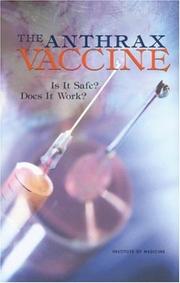| Listing 1 - 9 of 9 |
Sort by
|
Book
ISBN: 1421402521 9781421402529 9780801896965 0801896967 Year: 2010 Publisher: Baltimore : Johns Hopkins University Press,
Abstract | Keywords | Export | Availability | Bookmark
 Loading...
Loading...Choose an application
- Reference Manager
- EndNote
- RefWorks (Direct export to RefWorks)
Jones compellingly narrates the biography of this frightfully hardy disease from the ancient world through the present day.
Anthrax --- Biological weapons --- History.
Book
ISBN: 1624171826 9781624171826 1624171818 9781624171819 Year: 2013 Publisher: New York : Nova Science,
Abstract | Keywords | Export | Availability | Bookmark
 Loading...
Loading...Choose an application
- Reference Manager
- EndNote
- RefWorks (Direct export to RefWorks)
Anthrax. --- Bacillus anthracis. --- Environmental sampling. --- Environmental monitoring --- Sampling --- Anthrax bacterium --- Bacillus (Bacteria) --- Cumberland disease --- Gram-positive bacterial infections

ISBN: 0309083095 9786612083914 1282083910 0309557844 0309528895 9780309528894 9780309083096 0305083095 0309182743 Year: 2002 Publisher: Washington, D.C. : National Academy Press,
Abstract | Keywords | Export | Availability | Bookmark
 Loading...
Loading...Choose an application
- Reference Manager
- EndNote
- RefWorks (Direct export to RefWorks)
Anthrax - Vaccination. --- Anthrax --- Bacterial Vaccines --- Bacillaceae Infections --- Gram-Positive Bacterial Infections --- Vaccines --- Biological Products --- Bacterial Infections --- Complex Mixtures --- Bacterial Infections and Mycoses --- Chemicals and Drugs --- Diseases --- Anthrax Vaccines --- Public Health --- Health & Biological Sciences --- Communicable Diseases --- Vaccination --- Vaccination. --- Preventive inoculation
Book
ISBN: 0309579872 9786610248049 1280248041 9780309579872 9781280248047 Year: 2001 Publisher: Washington, D.C. : National Academy Press,
Abstract | Keywords | Export | Availability | Bookmark
 Loading...
Loading...Choose an application
- Reference Manager
- EndNote
- RefWorks (Direct export to RefWorks)
Anthrax -- Vaccination. --- Electronic books. -- local. --- Vaccines -- Effectiveness. --- Vaccines -- Safety measures. --- Public Health --- Health & Biological Sciences --- Communicable Diseases --- Anthrax --- Vaccines --- Vaccination. --- Effectiveness. --- Safety measures. --- Preventive inoculation --- Biologicals
Book
ISBN: 0309187192 9786613135063 128313506X 0309187206 9780309187190 9780309187206 9781283135061 0309216230 Year: 2011 Publisher: Washington, DC : National Academies Press (NAP),
Abstract | Keywords | Export | Availability | Bookmark
 Loading...
Loading...Choose an application
- Reference Manager
- EndNote
- RefWorks (Direct export to RefWorks)
Bioterrorism. --- Anthrax. --- Cumberland disease --- Bio-terrorism --- Biological terrorism --- Bioterrorism --- Law and legislation --- Gram-positive bacterial infections --- Terrorism

ISBN: 0520927109 1597344699 9780520927100 0585385203 9780585385204 0520222040 9780520222045 0520229177 9780520229174 9781597344692 Year: 1999 Publisher: Berkeley, [California] ; Los Angeles, [California] ; London, [England] : University of California Press,
Abstract | Keywords | Export | Availability | Bookmark
 Loading...
Loading...Choose an application
- Reference Manager
- EndNote
- RefWorks (Direct export to RefWorks)
In April of 1979 the city of Sverdlovsk in Russia's Ural Mountains was struck by a frightening anthrax epidemic. Official Soviet documents reported sixty-four human deaths resulting from the ingestion of tainted meat sold on the black market, but U.S.
Anthrax --- Biological weapons --- Bacteriological weapons --- Biological warfare agents --- Bioweapons --- Weapons of mass destruction --- Biosecurity --- Cumberland disease --- Gram-positive bacterial infections --- Epidemiology.
Book
ISBN: 9780262357777 0262357771 9780262538541 0262538547 026235778X Year: 2020 Publisher: Cambridge, Massachusetts : The MIT Press,
Abstract | Keywords | Export | Availability | Bookmark
 Loading...
Loading...Choose an application
- Reference Manager
- EndNote
- RefWorks (Direct export to RefWorks)
"In the long-shadow of September 11, 2001, infrastructures have undergone a significant reorganization. Letters, Power Lines, and Other Dangerous Things examines how new fears and worries over security have transformed the material and social outlines of infrastructure. The book follows three infrastructures-the postal system, freight rail, and the electric power system-and documents the subtle and explicit changes that have remade these systems. The book places the rise of "critical infrastructure protection"-a buzzword, a governing logic, and a multi-billion dollar funding priority-within a larger historical framework. Drawing from thousands of pages of regulatory filings, court documents, and other governmental documents, the book pieces together a larger story about risk and infrastructure. It identifies the political origins of infrastructure vulnerability-demonstrating how decades of political and economic restructuring ("deregulation") created system that were both politically unaccountable and vulnerable to systemic failure; and it examines how a cross-section of actors-including workers, civic groups, city councils, bureaucrats, and others-attempted to leverage new fears about infrastructure danger into reinvigorated systems of public accountability. Put another way, it examines the social and technical processes that made infrastructure dangerous; and then follows the ways in which these "dangerous things" were made safe and secure. The book offers a reminder that infrastructures always order they organize different publics, uses, ideas about what and who a system is for, into a tentative hierarchy. And security presents an opportunity to revisit and in some case remake these orders. The book provides a window into how infrastructures are made and remade sometimes in surprising and contradictory ways"--
Infrastructure (Economics) --- Security measures. --- Capital, Social (Economics) --- Economic infrastructure --- Social capital (Economics) --- Social infrastructure --- Social overhead capital --- Economic development --- Human settlements --- Public goods --- Public works --- Capital --- Infrastructure --- security --- vulnerability --- risk --- politics --- risk assessment --- 911 --- deregulation --- cybersecurity --- power lines --- electric grid --- USPS --- mail --- anthrax --- transportation networks --- homeland security --- critical infrastructure --- TSA --- regulation --- detection --- securitization --- Security measures --- SCIENCE, TECHNOLOGY & SOCIETY/General --- SOCIAL SCIENCES/Political Science/General
Book
ISBN: 1280123206 9786613527066 0309218098 9780309218092 9781280123207 6613527068 9780309218085 030921808X Year: 2012 Publisher: Washington, D.C. : National Academies Press,
Abstract | Keywords | Export | Availability | Bookmark
 Loading...
Loading...Choose an application
- Reference Manager
- EndNote
- RefWorks (Direct export to RefWorks)
"If terrorists released Bacillus anthracis over a large city, hundreds of thousands of people could be at risk of the deadly disease anthrax-caused by the B. anthracis spores-unless they had rapid access to antibiotic medical countermeasures (MCM). Although plans for rapidly delivering MCM to a large number of people following an anthrax attack have been greatly enhanced during the last decade, many public health authorities and policy experts fear that the nation's current systems and plans are insufficient to respond to the most challenging scenarios, such as a very large-scale anthrax attack. The U.S. Department of Health and Human Services' Office of the Assistant Secretary for Preparedness and Response commissioned the Institute of Medicine to examine the potential uses, benefits, and disadvantages of strategies for repositioning antibiotics. This involves storing antibiotics close to or in the possession of the people who would need rapid access to them should an attack occur. Prepositioning antibiotics for anthrax reviews the scientific evidence on the time window in which antibiotics successfully prevent anthrax and the implications for decision making about prepositioning, describes potential prepositioning strategies, and develops a framework to assist state, local, and tribal public health authorities in determining whether prepositioning strategies would be beneficial for their communities. However, based on an analysis of the likely health benefits, health risks, and relative costs of the different prepositioning strategies, the book also develops findings and recommendations to provide jurisdictions with some practical insights as to the circumstances in which different prepositioning strategies may be beneficial. Finally, the book identifies federal- and national-level actions that would facilitate the evaluation and development of prepositioning strategies. Recognizing that communities across the nation have differing needs and capabilities, the findings presented in this report are intended to assist public health officials in considering the benefits, costs, and trade-offs involved in developing alternative prepositioning strategies appropriate to their particular communities."--Publisher's description.
Anthrax --- Public health. --- Biosecurity. --- Human security --- Biological weapons --- Communicable diseases --- Public health --- Community health --- Health services --- Hygiene, Public --- Hygiene, Social --- Public health services --- Public hygiene --- Social hygiene --- Health --- Human services --- Biosecurity --- Health literacy --- Medicine, Preventive --- National health services --- Sanitation --- Vaccination. --- Safety measures --- Prevention --- Preventive inoculation
Book
ISBN: 1280592923 9786613622754 0520946057 Year: 2010 Publisher: Berkeley, Calif. : New York, N.Y. : University of California Press ; Milbank Memorial Fund,
Abstract | Keywords | Export | Availability | Bookmark
 Loading...
Loading...Choose an application
- Reference Manager
- EndNote
- RefWorks (Direct export to RefWorks)
Now revised and expanded to cover today's most pressing health threats, Public Health Law and Ethics probes the legal and ethical issues at the heart of public health through an incisive selection of government reports, scholarly articles, and relevant court cases. Companion to the internationally acclaimed text Public Health Law: Power, Duty, Restraint, this reader can also be used as a stand-alone resource for students, practitioners, scholars,and teachers. It encompasses global issues that have changed the shape of public health in recent years including anthrax, SARS, pandemic flu, biosecurity, emergency preparedness, and the transition from infectious to chronic diseases caused by lifestyle changes in eating and physical activity. In addition to covering these new arenas, it includes discussion of classic legal and ethical tensions inherent to public health practice, such as how best to balance the police power of the state with individual autonomy.
Public health laws --- Public health --- Moral and ethical aspects. --- anthrax. --- articles. --- bioethics. --- biosecurity. --- chronic diseases. --- court cases. --- diet and exercise. --- emergency preparedness. --- ethical issues. --- flu. --- global issues. --- government reports. --- health and wellness. --- health threats. --- human condition. --- infectious diseases. --- law and ethics. --- law students. --- legal issues. --- medical practitioners. --- nonfiction. --- pandemics. --- police power. --- political. --- public health law. --- public health practices. --- sars. --- scholars. --- students. --- teachers.
| Listing 1 - 9 of 9 |
Sort by
|

 Search
Search Feedback
Feedback About UniCat
About UniCat  Help
Help News
News